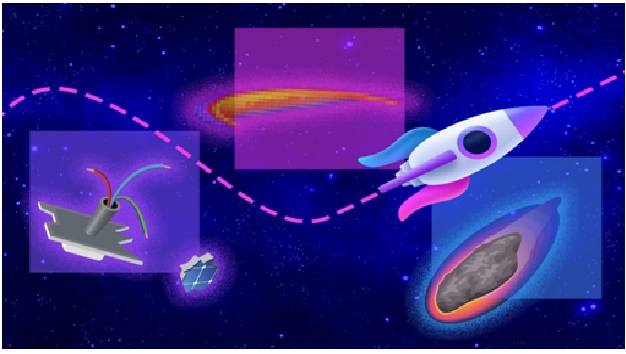Charting a safe course through a highly uncertain environment
An autonomous spacecraft exploring far-flung regions of the universe descends through the atmosphere of a distant exoplanet. The vehicle, and the researchers who programmed it, don’t know much about this environment.
Researchers at MIT have developed a technology that can help this spacecraft land safely. Their approach could enable an autonomous vehicle to plot a reasonably safe trajectory in highly uncertain conditions where there are many uncertainties regarding environmental conditions and objects colliding with the vehicle. [1]

Figure 1. Charting a safe course through a highly uncertain environment
Figure 1 shows this method can help the vehicle find a safe course around obstacles that move randomly and change shape over time. It plots a safe trajectory to the target region even when the vehicle’s starting point is not exactly known and when it is not clear exactly how the vehicle will move due to external influences such as wind, ocean currents or rough terrain. [2]
This is the first technique to address the problem of trajectory planning with many simultaneous uncertainties and complex safety constraints, says co-lead author Weiqiao Han, a graduate student in the Department of Electrical Engineering and Computer Science and the Computer Science and Artificial Intelligence Laboratory (CSAIL). [3]
Charting courses
They evaluated the technique using several simulated navigation scenarios. In one, they modeled an underwater vehicle charting a course from some uncertain position, around a number of strangely shaped obstacles, to a goal region. It was able to safely reach the goal at least 99 percent of the time. They also used it to map a safe trajectory for an aerial vehicle that avoided several 3D flying objects that have uncertain sizes and positions and could move over time, while in the presence of strong winds that affected its motion. Using their system, the aircraft reached its goal region with high probability.[4]
Using this approach, their algorithms formulate trajectory planning as a probabilistic optimization problem. This is a mathematical programming framework that allows the robot to achieve planning objectives, such as maximizing velocity or minimizing fuel consumption, while considering safety constraints, such as avoiding obstacles. [4]
References:
- https://darik.news/massachusetts/charting-a-safe-course-through-a-highly-uncertain/202205597567.html
- https://newsprepare.com/index.php/2022/05/23/charting-a-safe-course-through-a-highly-uncertain-environment-sciencedaily/
- https://news.knowledia.com/IN/en/articles/charting-a-safe-course-through-a-highly-uncertain-environment-7cc53bbcaf05d49c4959f81cb253d710e15648c7
- https://www.sciencedaily.com/releases/2022/05/220523150656.htm
Cite this article:
Thanusri swetha J (2022), Charting a safe course through a highly uncertain environment, Anatechmaz, pp. 295

